
Garden of the 67
Juan Pablo González presents Garden of the 67, designed by JNMX; a city jungle around a body of water in the historic center of Merida.
In recent months we have witnessed important and alarming changes in the climatic conditions of our planet Earth, which have forced us to question the status of our natural habitats, including landscaping.
Based on this reflection, we have realized that native plants share an organic symbiosis with the environment, and are linked in their DNA to the land from which they arise. They are adapted to the local environment, and therefore do not require excessive care that could cause losses and environmental imbalances; in conclusion, they promote healthy soils.
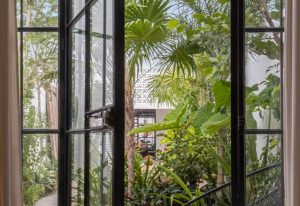
View from inside
Photography: Mauricio Manzanilla
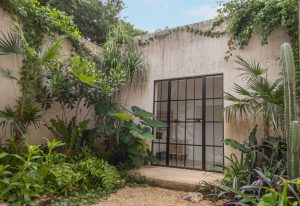
Vegetación Vegetation
Fotografía / Photography: Mauricio Manzanilla
“Designing a garden is an art that entails conceptualizing and thereby generating a structure that will give character, and more importantly, a meaning to the green area, where each plant performs a special function to respond to the place,” explains the architect Rodrigo Escamilla, founder of Native Mexican Gardens. According to the expert, intervening in natural spaces with this type of botany helps to reinforce interdependent relationships between living beings on the ground. “There is no better plant than the one that inhabits its site”, explains the leader of JNMX, responsible for the “Jardín de la 67” project, inspired by an exuberant shelter of tropical vegetation that arises spontaneously, like oases when they appear in the desert.

Corte / Section
Ilustración / Illustration: JNMX
His main objective in this project was to create an urban jungle around a body of water, which is located on an old property that was reconstructed and located in the historic center of Mérida.
From that body of water, which is a pool, is how the vegetation was associated with the environment; The type of plants and foliage that best match the existing elements, such as humidity, sunlight and architectural materials that surround the property, were chosen to create contexts that were closer to natural environments, in this case, those of the Peninsula. To design each place, the architect walks through the land and as he enters it, he begins to define the type of vegetation that he will use, choosing those that go according to the dimensions and conditions of the space.
In the case of the “Jardín de la 67” project, due to the type of soil and state in which it is located, a vegetation resistant to soil conditions was chosen, in which a high degree of alkalinity prevails.
After the soil had been loosened and cleaned, the entire planting space was enriched with regular soil and leaf soil, supplemented
with vermicompost, without leaving aside the “mulch” bed, which is applied to protect the soil. from overexposure to the sun, reduce the appearance of unwanted weeds and, most importantly, preserve moisture and enrich the soil.
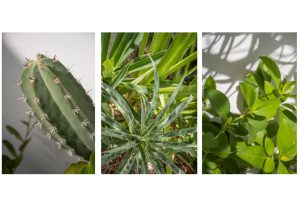
Vegetation
Photography: Mauricio Manzanilla
Finally, the vegetation was distributed in the planters, others were planted directly on the ground and clay pots were also used, because the substrate was very superficial, to conserve humidity and for aesthetics. As one enters the central patio, which is hidden by the old construction, the attention is immediately directed towards the plants that stand out due to their height such as the Florida thatch palm (Thrinax radiata), Bloodwood tree (Haematoxylum campechianum), Mexican ponytail (Beaucarnea pliabilis), Clusia (Clusia sp.), Sea Grape (Coccoloba uvifera), White frangipani (Plumeria obtusa) and the Mexican silver palm (Coccothrinax readii). “These species were chosen with advanced matu- rity and were placed symmetrically as they were two important characteristics that the owners were looking for. They set the tone where you should direct your eyes and they are there with the purpose of giving a structure to the exteriors and naturally limiting the green areas. That is why the structures of the gardens arise from the visuals, and with them the order”, shares Rodrigo about his professional work.
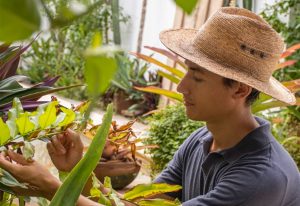
Architect Rodrigo Escamilla
Photography: Mauricio Manzanilla
“Once the structure was delimited, preserving its relationship with the aquatic context that had been proposed, we proceeded to emphasize the residual spaces with accent vegetation and filling with medium-low height that provide a variety of textures and tones, including plants such as: Mangrove ferns (Acrostichum sp.), Bravaisia berlandieriana, Icaco (Chrysobalanus icaco), Beach spider lilies (Hymenocallis littoralis), and a type of native Crinum (Crinum erubescens)”, explains the architect about the selection of vegetation in this garden.
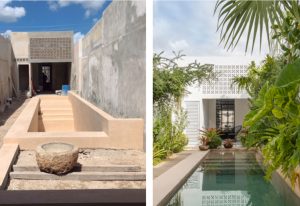
Proyecto antes y después / Project before and after
Fotografía / Photography: Mauricio Manzanilla
In addition, some shrubs were added, such as Blue snakeweed (Stachytarpheta cayennensis); Croton peraeruginosus; and Malvaviscus arboreus, a flowering beach shrub. Also in an effort to give it a jungle touch, species like Xanthosoma yucatanense were added and, fi- nally, Anilkab (Bignonia diversifolia) climbing species were planted, which allow to soften the views towards the perimeter fence. As for the herbaceous accents, they cause a visual stampede for visitors through the different shapes and textures. Finally, two more areas were added that function as a continuation of the planter that runs along the pool with the aim of increasing the green area and the permeability of the land, to avoid future flooding.
With native vegetation, it was sought to ensure greater adaptability to environmental conditions and require less maintenance. Another of the benefits of native vegetation is that its integration into spaces, as in the case of the “Jardín de la 67”, helps to considerably reduce and control the appearance of pests, in contrast to exotic or allochthonous plants that are usually the favorites of many insects, and thus reduce the widespread use of pesticides and fertilizers that greatly damage the groundwater table. These native gardens are a dynamic living system and share our heritage. They can change our way of life in our personal environment, impacting aesthetically, culturally, socially, but above all, positively favoring the environment, stabilizing its biodiversity and helping to heal and recover the soils of our habitat.
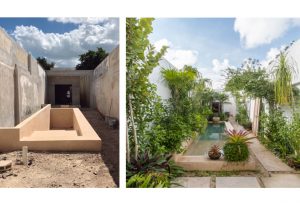
Project before and after
Photography: Mauricio Manzanilla











